Taneli Riihonen
The Role of ISAC in 6G Networks: Enabling Next-Generation Wireless Systems
Oct 06, 2025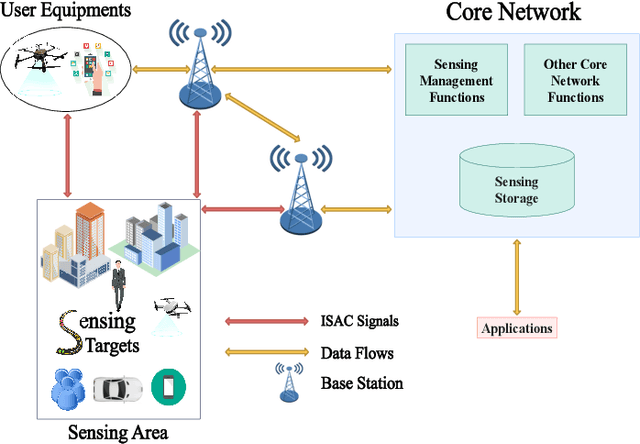
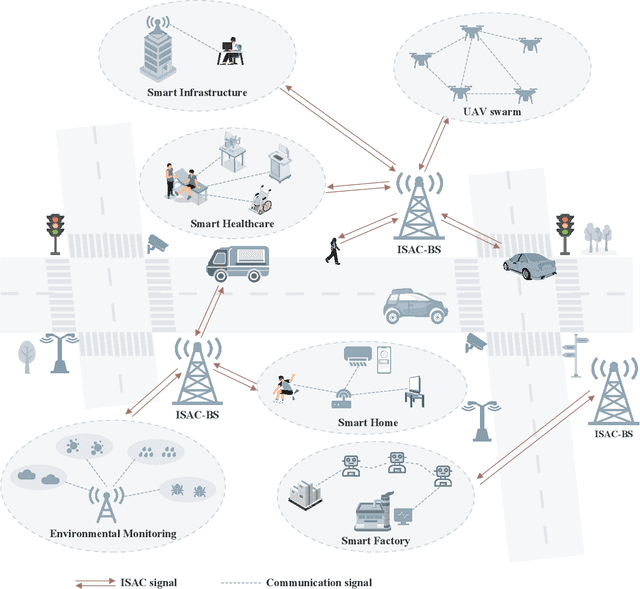
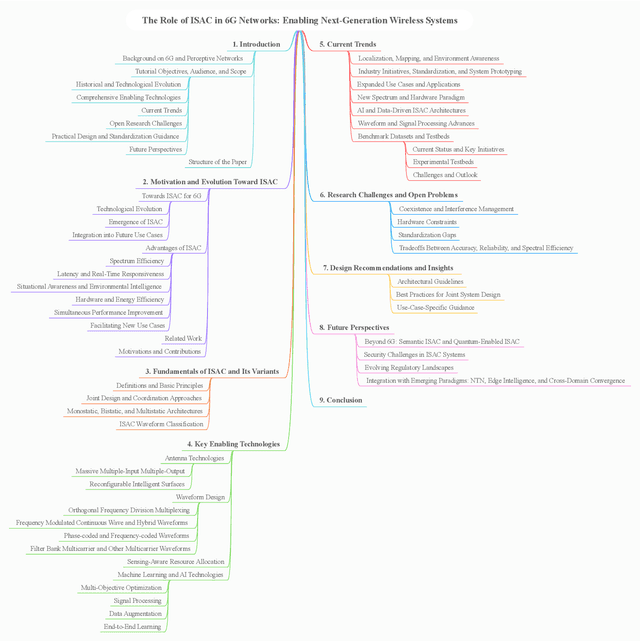
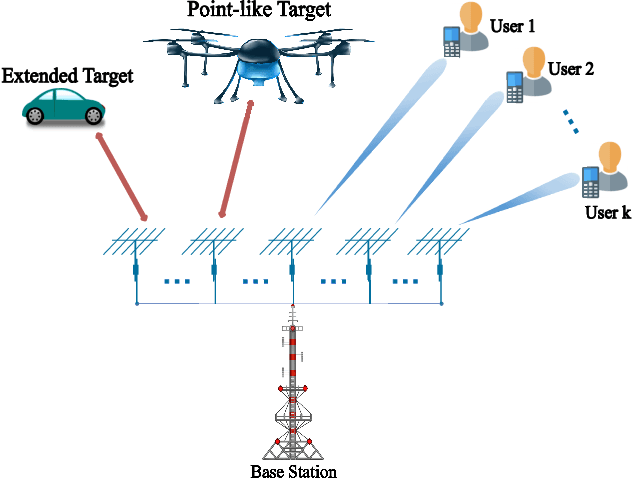
Abstract:The commencement of the sixth-generation (6G) wireless networks represents a fundamental shift in the integration of communication and sensing technologies to support next-generation applications. Integrated sensing and communication (ISAC) is a key concept in this evolution, enabling end-to-end support for both communication and sensing within a unified framework. It enhances spectrum efficiency, reduces latency, and supports diverse use cases, including smart cities, autonomous systems, and perceptive environments. This tutorial provides a comprehensive overview of ISAC's role in 6G networks, beginning with its evolution since 5G and the technical drivers behind its adoption. Core principles and system variations of ISAC are introduced, followed by an in-depth discussion of the enabling technologies that facilitate its practical deployment. The paper further analyzes current research directions to highlight key challenges, open issues, and emerging trends. Design insights and recommendations are also presented to support future development and implementation. This work ultimately try to address three central questions: Why is ISAC essential for 6G? What innovations does it bring? How will it shape the future of wireless communication?
Urban RIS-Assisted HAP Networks: Performance Analysis Using Stochastic Geometry
Jun 18, 2025Abstract:This paper studies a high-altitude platform (HAP) network supported by reconfigurable intelligent surfaces (RISs). The practical irregular placement of HAPs and RISs is modeled using homogeneous Poisson point processes, while buildings that cause blockages in urban areas are modeled as a Boolean scheme of rectangles. We introduce a novel approach to characterize the statistical channel based on generalized Beta prime distribution. Analytical expressions for coverage probability and ergodic capacity in an interference-limited system are derived and validated through Monte Carlo simulations. The findings show notable performance improvements and reveal the impact of various system parameters, including blockages effect which contribute in mitigating interference from the other visible HAPs. This proposed system could enhance connectivity and enable effective data offloading in urban environments.
Integrating RIS into HAP Networks for Improved Connectivity
Nov 06, 2024Abstract:This paper investigates a high-altitude platform (HAP) network enhanced with reconfigurable intelligent surfaces (RISs). The arbitrary placement of HAPs and RISs is modeled using stochastic geometry, specifically as homogeneous Poisson point processes. The HAP--RIS links are assumed to follow Rician fading, while the RIS--user links experience shadowed-Rician fading. The system's coverage probability and ergodic capacity are derived analytically and validated through Monte Carlo simulations. The results highlight significant performance gains and demonstrate the influence of various system parameters and fading conditions. The proposed system has potential for enhancing connectivity and data offloading in practical scenarios.
In-Band Full-Duplex MIMO Systems for Simultaneous Communications and Sensing: Challenges, Methods, and Future Perspectives
Oct 09, 2024

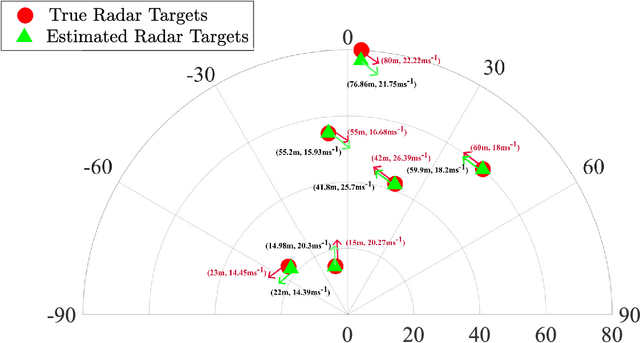

Abstract:In-band Full-Duplex (FD) Multiple-Input Multiple-Output (MIMO) systems offer a significant opportunity for Integrated Sensing and Communications (ISAC) due to their capability to realize simultaneous signal transmissions and receptions. This feature has been recently exploited to devise spectrum-efficient simultaneous information transmission and monostatic sensing operations, a line of research typically referred to as MIMO FD-ISAC. In this article, capitalizing on a recent FD MIMO architecture with reduced complexity analog cancellation, we present an FD-enabled framework for simultaneous communications and sensing using data signals. In contrast to communications applications, the framework's goal is not to mitigate self interference, since it includes reflections of the downlink data transmissions from targets in the FD node's vicinity, but to optimize the system parameters for the intended dual functionality. The unique characteristics and challenges of a generic MIMO FD-ISAC system are discussed along with a broad overview of state-of-the-art special cases, including numerical investigations. Several directions for future work on FD-enabled ISAC relevant to signal processing communities are also provided.
Enhancing HAP Networks with Reconfigurable Intelligent Surfaces
Sep 16, 2024Abstract:This paper presents and analyzes a reconfigurable intelligent surface (RIS)-based high-altitude platform (HAP) network. Stochastic geometry is used to model the arbitrary locations of the HAPs and RISs as a homogenous Poisson point process. Considering that the links between the HAPs, RISs, and users are $\kappa$--$\mu$ faded, the coverage and ergodic capacity of the proposed system are expressed. The analytically derived performance measures are verified through Monte Carlo simulations. Significant improvements in system performance and the impact of system parameters are demonstrated in the results. Thus, the proposed system concept can improve connectivity and data offloading in smart cities and dense urban environments.
Analog Beamforming for In-Band Full-Duplex Phased Arrays with Quantized Phase Shifters under a Per-Antenna Received Power Constraint
Jan 25, 2024Abstract:This letter develops a novel transmit beamforming (BF) design for canceling self-interference (SI) in analog in-band full-duplex phased arrays. Our design maximizes transmit BF gain in a desired direction while simultaneously reducing SI power to below a specified threshold on per-antenna basis to avoid saturating receive-chain components, such as LNAs. Core to our approach is that it accounts for real-world phase shifters used in analog phased array systems, whose limited resolution imposes non-convex constraints on BF design. We overcome this by transforming these non-convex constraints into convex polygon constraints, which we then solve through semidefinite relaxation and a rank refinement procedure. Numerical results show that our proposed BF scheme reliably cancels SI to the target power threshold at each receive antenna while sacrificing little in transmit BF gain, even with modest phase shifter resolution.
Beamformer Design and Optimization for Full-Duplex Joint Communication and Sensing at mm-Waves
Sep 13, 2021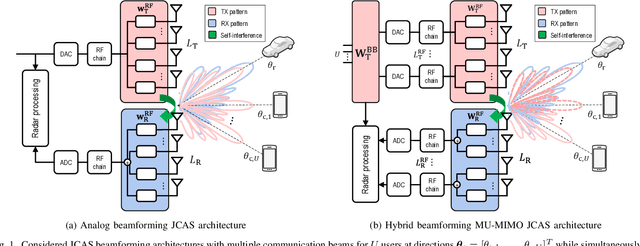
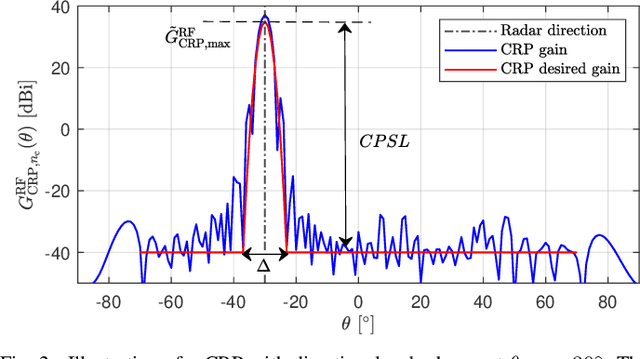
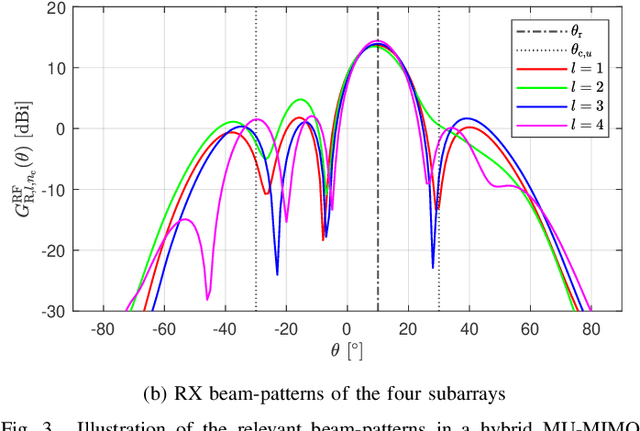
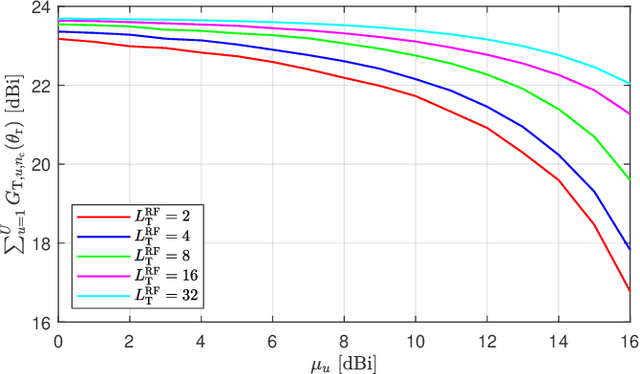
Abstract:In this article, we study the joint communication and sensing (JCAS) paradigm in the context of millimeter-wave (mm-wave) mobile communication networks. We specifically address the JCAS challenges stemming from the full-duplex operation and from the co-existence of multiple simultaneous beams for communications and sensing purposes. To this end, we first formulate and solve beamforming optimization problems for hybrid beamforming based multiuser multiple-input and multiple-output JCAS systems. The cost function to be maximized is the beamformed power at the sensing direction while constraining the beamformed power at the communications directions, suppressing interuser interference and cancelling full-duplexing related self-interference (SI). We then also propose new transmitter and receiver beamforming solutions for purely analog beamforming based JCAS systems that maximize the beamforming gain at the sensing direction while controlling the beamformed power at the communications direction(s), cancelling the SI as well as eliminating the potential reflection from the communication direction and optimizing the combined radar pattern (CRP). Both closed-form and numerical optimization based formulations are provided. We analyze and evaluate the performance through extensive simulations, and show that substantial gains and benefits in terms of radar transmit gain, CRP, and SI suppression can be achieved with the proposed beamforming methods.
HybridDeepRx: Deep Learning Receiver for High-EVM Signals
Jun 30, 2021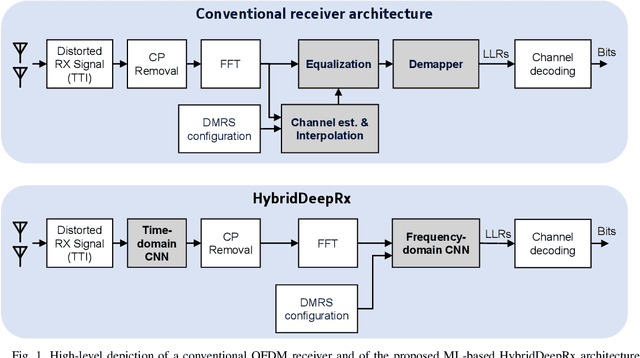
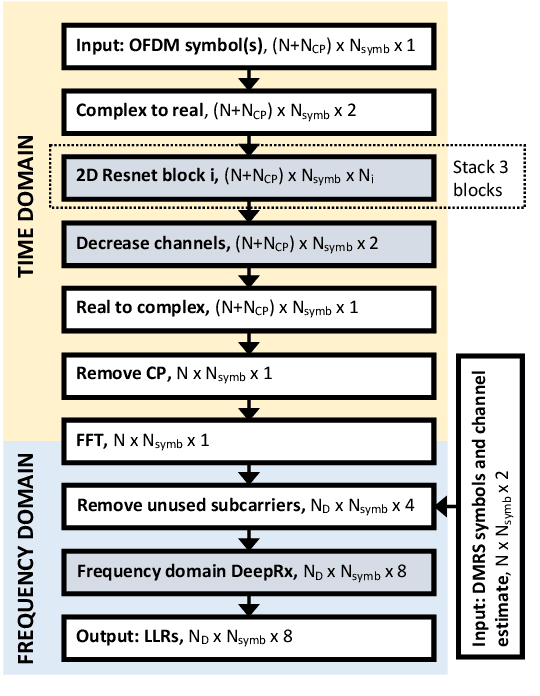
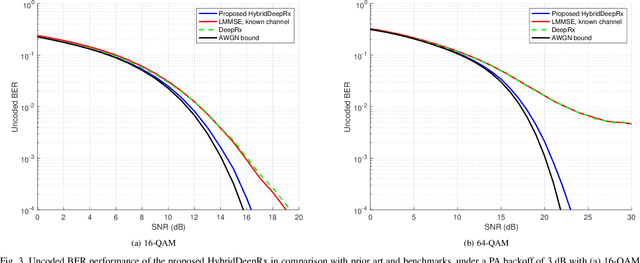
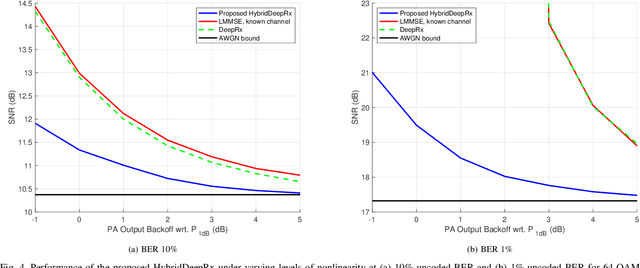
Abstract:In this paper, we propose a machine learning (ML) based physical layer receiver solution for demodulating OFDM signals that are subject to a high level of nonlinear distortion. Specifically, a novel deep learning based convolutional neural network receiver is devised, containing layers in both time- and frequency domains, allowing to demodulate and decode the transmitted bits reliably despite the high error vector magnitude (EVM) in the transmit signal. Extensive set of numerical results is provided, in the context of 5G NR uplink incorporating also measured terminal power amplifier characteristics. The obtained results show that the proposed receiver system is able to clearly outperform classical linear receivers as well as existing ML receiver approaches, especially when the EVM is high in comparison with modulation order. The proposed ML receiver can thus facilitate pushing the terminal power amplifier (PA) systems deeper into saturation, and thereon improve the terminal power-efficiency, radiated power and network coverage.
Radio-based Sensing and Environment Mapping in Millimeter-Wave 5G and Beyond Networks
Feb 23, 2021
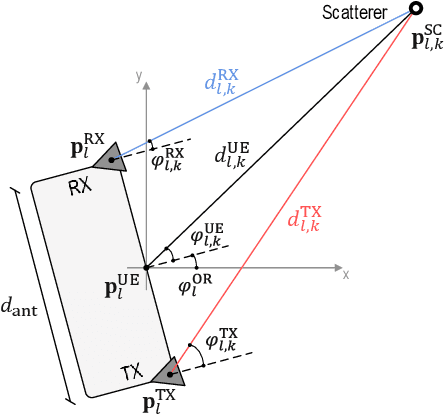
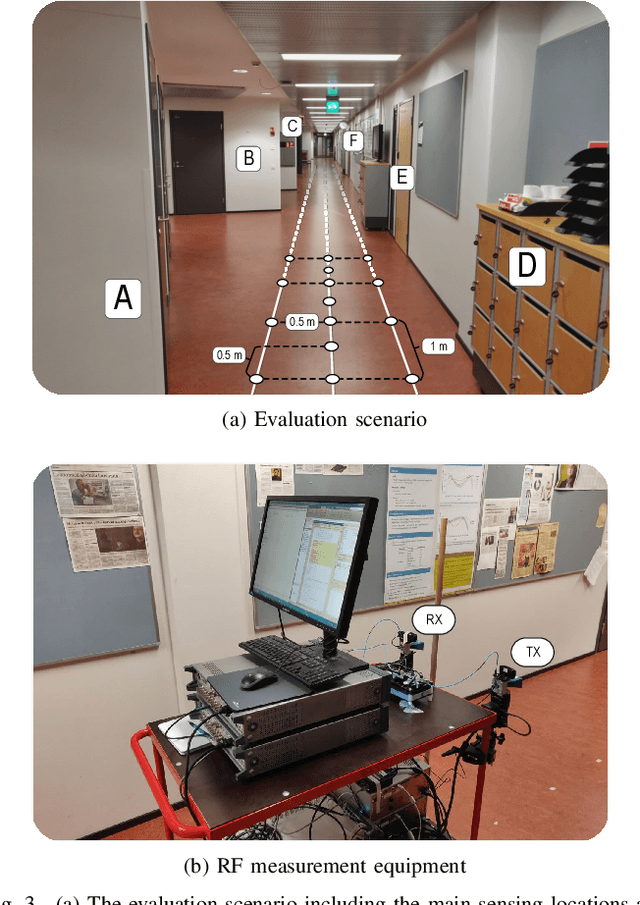
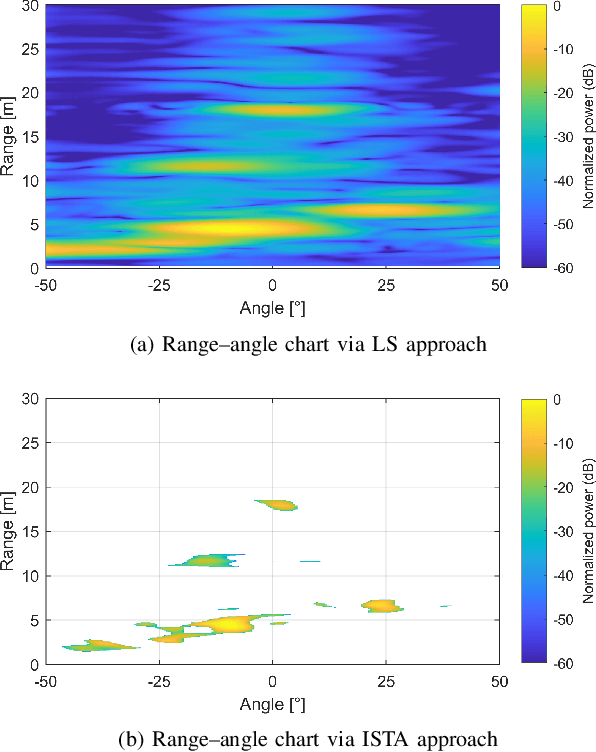
Abstract:Integrating efficient connectivity, positioning and sensing functionalities into 5G New Radio (NR) and beyond mobile cellular systems is one timely research paradigm, especially at mm-wave and sub-THz bands. In this article, we address the radio-based sensing and environment mapping prospect with specific emphasis on the user equipment (UE) side. We first describe an efficient l1-regularized least-squares (LS) approach to obtain sparse range--angle charts at individual measurement or sensing locations. For the subsequent environment mapping, we then describe both grid-based static solution as well as more advanced tracking-based dynamic approaches, where interaction multiple-model extended Kalman filtering and smoothing are utilized. We provide numerical indoor mapping results at 28~GHz band deploying OFDM-based 5G NR uplink waveform with 400~MHz channel bandwidth, covering both accurate ray-tracing based as well as actual RF measurement results. The results illustrate the superiority of the dynamic tracking-based solutions, while overall demonstrate the excellent prospects of radio-based environment sensing and mapping in future mm-wave networks.
Improved Coefficients for the Karagiannidis-Lioumpas Approximations and Bounds to the Gaussian Q-Function
Jan 19, 2021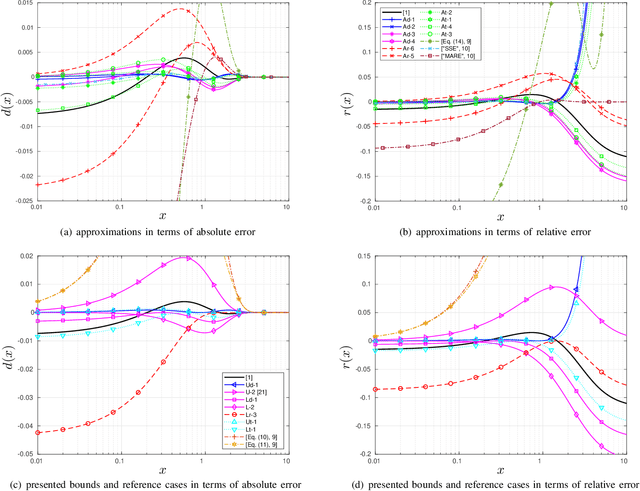
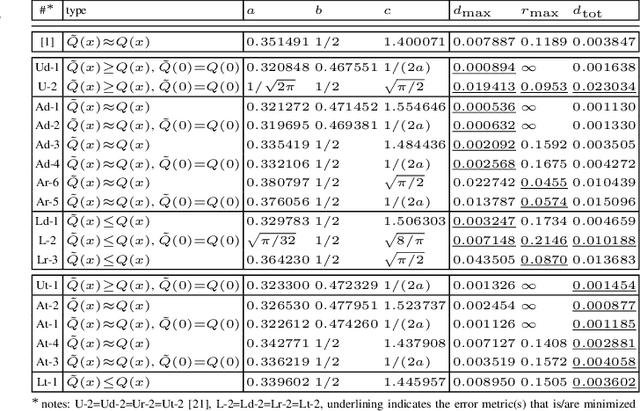
Abstract:We revisit the Karagiannidis-Lioumpas (KL) approximation of the Q-function by optimizing its coefficients in terms of absolute error, relative error and total error. For minimizing the maximum absolute/relative error, we describe the targeted uniform error functions by sets of nonlinear equations so that the optimized coefficients are the solutions thereof. The total error is minimized with numerical search. We also introduce an extra coefficient in the KL approximation to achieve significantly tighter absolute and total error at the expense of unbounded relative error. Furthermore, we extend the KL expression to lower and upper bounds with optimized coefficients that minimize the error measures in the same way as for the approximations.
 Add to Chrome
Add to Chrome Add to Firefox
Add to Firefox Add to Edge
Add to Edge